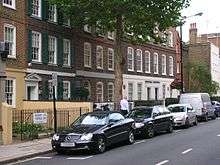Ebury Street
Ebury Street (/ˈiːbəri/) is a street in Belgravia, City of Westminster, London. It runs from a Grosvenor Gardens junction south-westwards to Pimlico Road. It was built mostly in the period 1815 to 1860.

Odd numbers 19 to 231 are on the south-east side; the others, 16 to 230, are opposite. Numbers 2 to 14 have largely been replaced by a renamed terrace of eight houses known as Lygon Place, recessed behind a small green.
History
A local estate, "Eia", is mentioned in the Domesday Book.[1]
The surviving houses 180–188 were called "Fivefields Row" when Mozart lived there in 1764. Small portions on the south-east side are late-20th-century mid-rise apartments set back from the road, mainly replacing sections damaged by bombing in the London Blitz.
22b Ebury Street was built in 1830 as a Baptist church. It was divided into flats in the 20th century.
Immediately following World War I, number 42 was the workplace or head office of the "Soldiers' Embroidery Industry". Textile bags and workboxes were so-labelled, adding the words "Made by the Totally Disabled", i.e. disabled veterans doing rehabilitation work.
Notable buildings
Mozart Terrace was in the late 18th century known as Fivefields Row. It can also be numerically addressed as Ebury Street.
Niche restaurants
La Poule au Pot is an expensive restaurant leased from Grosvenor Estates, below social housing managed by Peabody. In 2006 it won two awards in Harden's guide.
Ken Lo's Memories of China is a restaurant established in 1981 by Ken Lo (d. 2001).
Other uses
Where Ebury Street meets Pimlico Road is a triangular green with seating and a bronze statue of Mozart (aged 8) by Philip Jackson. The triangle is unofficially called Mozart Place, Mozart Green or Mozart Square, the latter reflecting the localised misnomer of "squares" in two notable instances: a very thin rectangle grid with a main road running through its longer bisection forms Eaton Square and Chester Square is likewise more street than green. A minority of houses have been converted to hotels.
Buildings dating from the mid to late 20th century front parts of the street toward either end: Coleshill Flats, Kylestrome House, Kilmuir House (a conversion), and Belgravia Court. Numbers 2 to 14 have largely been replaced by a renamed terrace of eight houses known as Lygon Place, recessed behind a small green (see below).
Notable residents
- Ian Fleming lived from 1934 to 1945 at 22b.[2]
- F. E. Smith, 1st Earl of Birkenhead lived at number 32.[2]
- In 1847 Alfred Tennyson, 1st Baron Tennyson lived at number 42.
- Noel Coward kept a room at number 111 which his parents had run as a lodging house.
- George Moore lived and died at number 121.
- Wolfgang Amadeus Mozart lived at "Fivefields Row" from 5 August to 24 September 1764, approximately number 180.
- Vita Sackville-West lived with her husband, Harold Nicolson, at number 182. Their son Nigel was born here.
- An early photographer, William Downey (1829–1915), had studios at numbers 57 and 61. He made some of the most famous photographs of celebrities of his day — Sarah Bernhardt, Oscar Wilde and the then Princess of Wales.
- The photographer Mabel Sophia Clerke, operating as M. Shadwell Clerke, had a studio at 117 Ebury Street in the early 20th century.[3]
Lygon Place
Lygon Place is a terrace of initial-category (Grade II-) listed buildings recessed by a small green and facing the street. The terrace dates from about 1900 and is an Arts and Crafts-influenced design, by Eustace Balfour and Hugh Thackeray Turner. Notable former residents include Freeman Freeman-Thomas, 1st Marquess of Willingdon. Number 5 was a residence of the Italian Air Attaché. Institutions based here included the Margarine and Shortening Manufacturers' Association; the Lion Services Club; and the Institution of Highways and Transportation.
Gallery
- Bronze statue of Mozart

References
- "The Acquisition of the Estate | British History Online". British-history.ac.uk. Retrieved 19 March 2017.
- Affixed with a blue plaque
- "Photograph portrait of Mr Harry Lauder", National Archives at Kew. Also see the stamp on Dora-Ohlfsen-Bagge, 1908, Art Gallery of New South Wales.